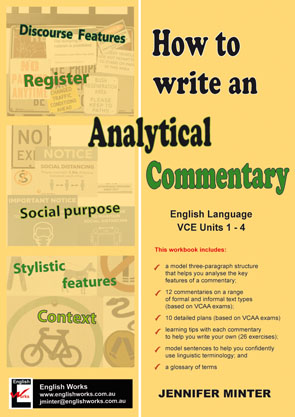
Comment on : Contextual factors ; Social purpose and Register; Stylistic and discourse features of the text.
In the VCAA Examination report, the assessors note: “Select the prominent features of the text for analysis in Section B. Refine the structure by putting context, purpose, register in the introductory paragraph, thus establishing a framework for the analysis.” (2019 VCAA Assessors report)
One tip: read through the text and identify the various social purposes (usually between 3 to 5). Choose the most prominent social purpose as the feature of paragraph 2 and weave the other purposes throughout your commentary — likewise, prosodic features.
Firstly: identify the various social purposes : See the VCAA Exam 2018: Governor General’s speech (formal)
Do a quick dot-point plan of the various social purposes filtered throughout the text. You will need to weave these throughout your commentary as you link the techniques to the context and to the author’s meaning.
What are the various social purposes of the speech?
- To welcome and to congratulate all new Australian citizens
- To set the context: of Australia-wide celebrations
- Informative: to remind the new citizens of their “pledge” and to explain/ inform them about what this “pledge” means
- To welcome them to the diverse Australian story – and to give them a broad understanding of what Australian values are – what it means to be Australian
- To give some background understanding; to explain the cultural and historical diversity of Australia
- To give new citizens an idea of what Australia offers to them – what becoming a citizen means for their future
- To create social distance: in order to emphasise the privilege of becoming a citizen: The Governor General uses the authority of his high office to make the citizenship ceremony as meaningful as possible (Government House- location)
- To reduce social distance where appropriate by including members of the audience – by giving personal stories of his own experience and Little Lewis – positive face needs – inclusion, welcoming tactics – to treat the citizens as people with their own stories
- GG pays respect to the Indigenous culture – respecting their negative face needs
See: the commentary: 2018 VCAA exam.
- See a simple and effective example: Jan’s Blog
- A range of commentaries (formal/informal/spoken/written)
- Return to our Welcome Page: Overview of English Works Notes and Resources